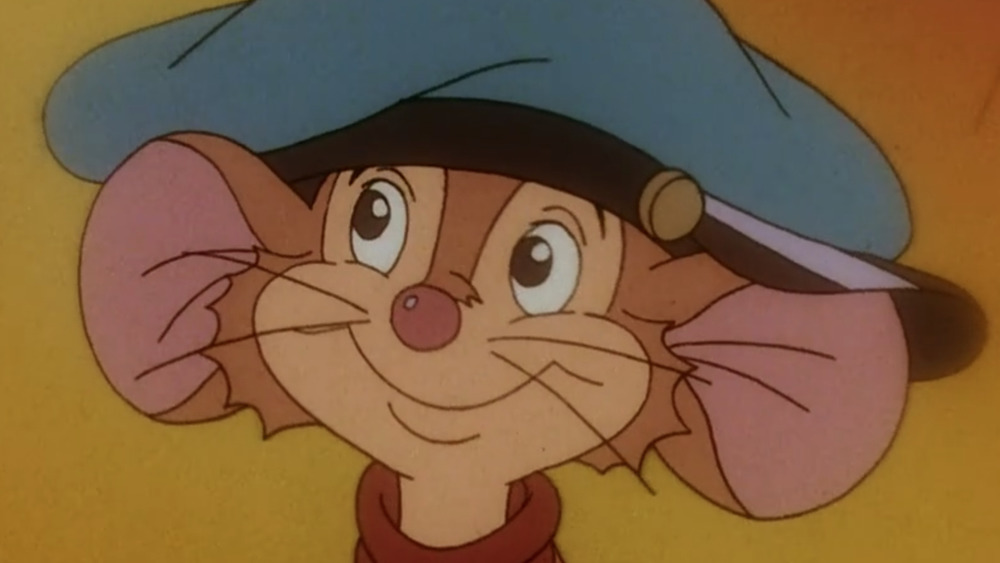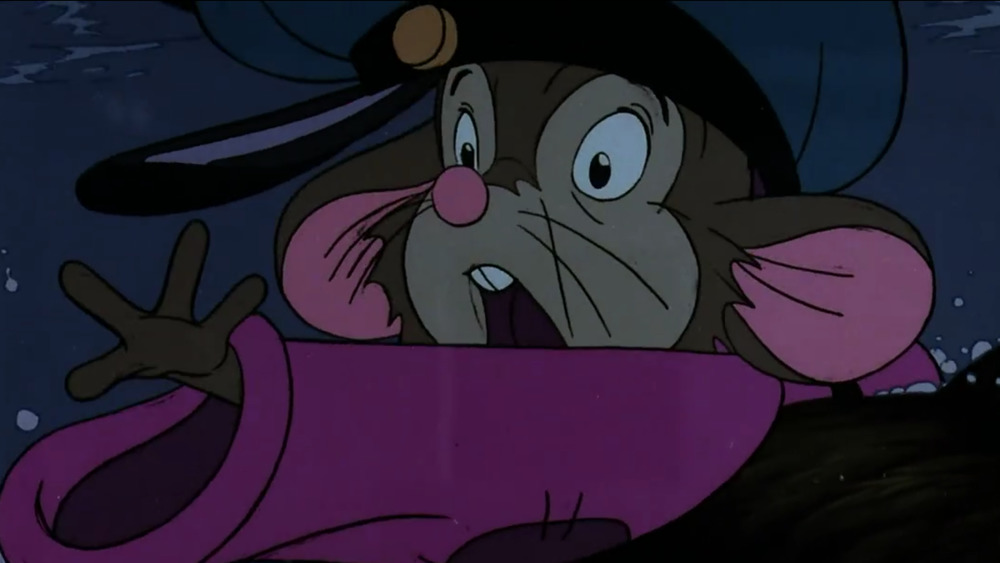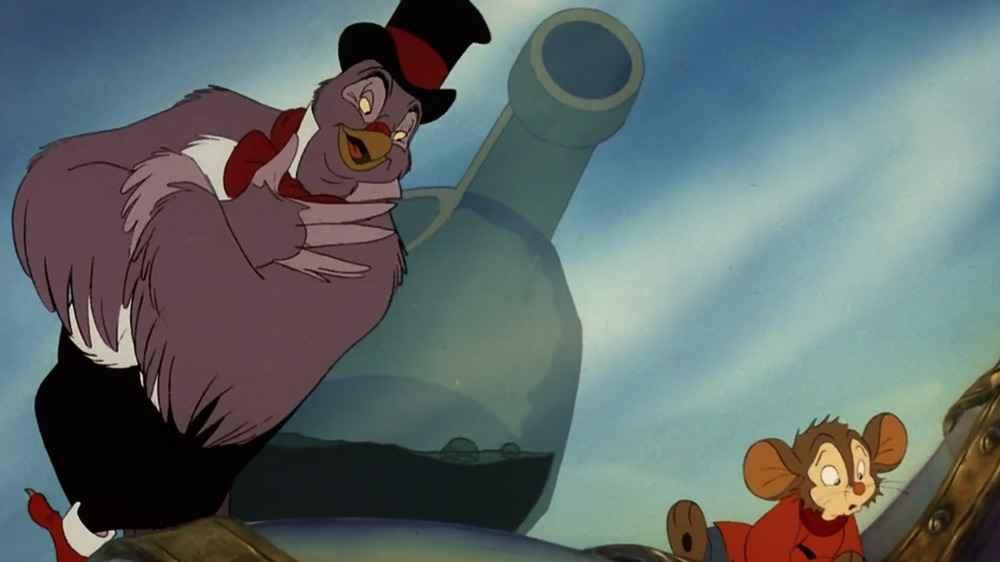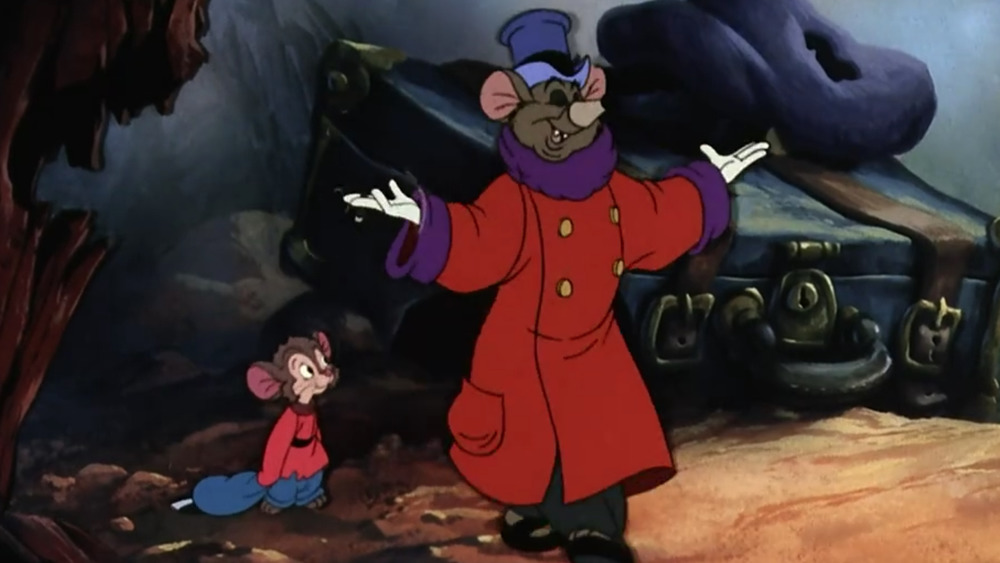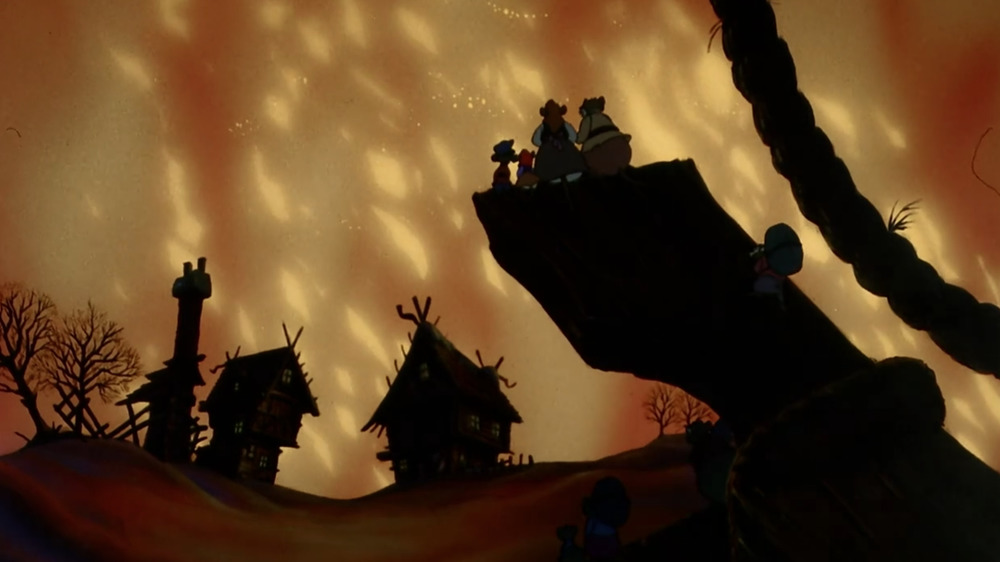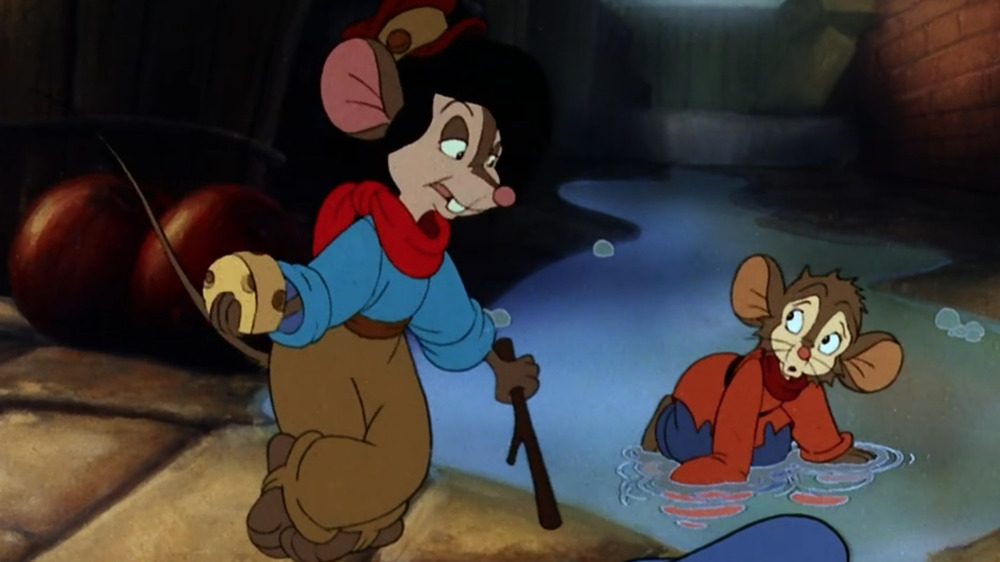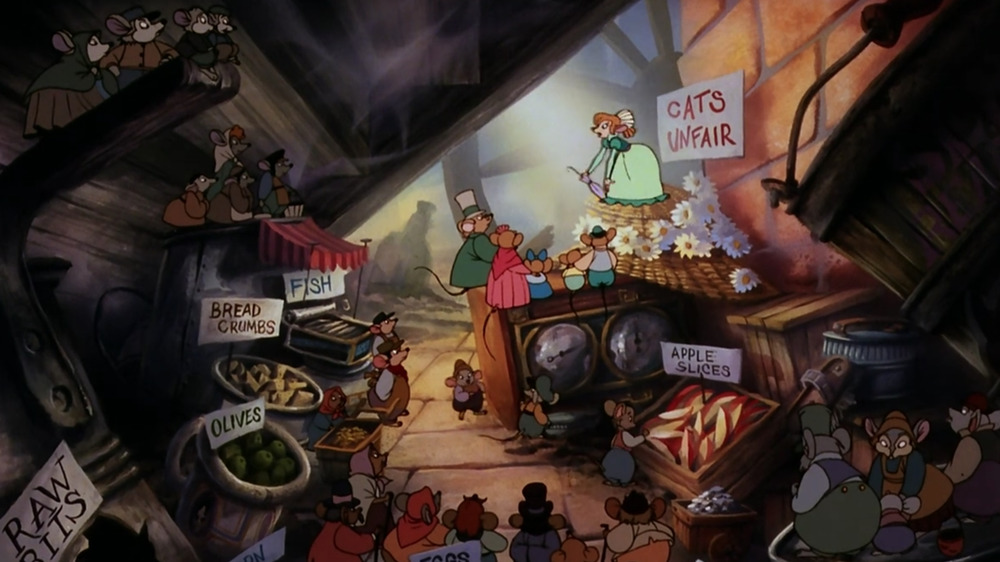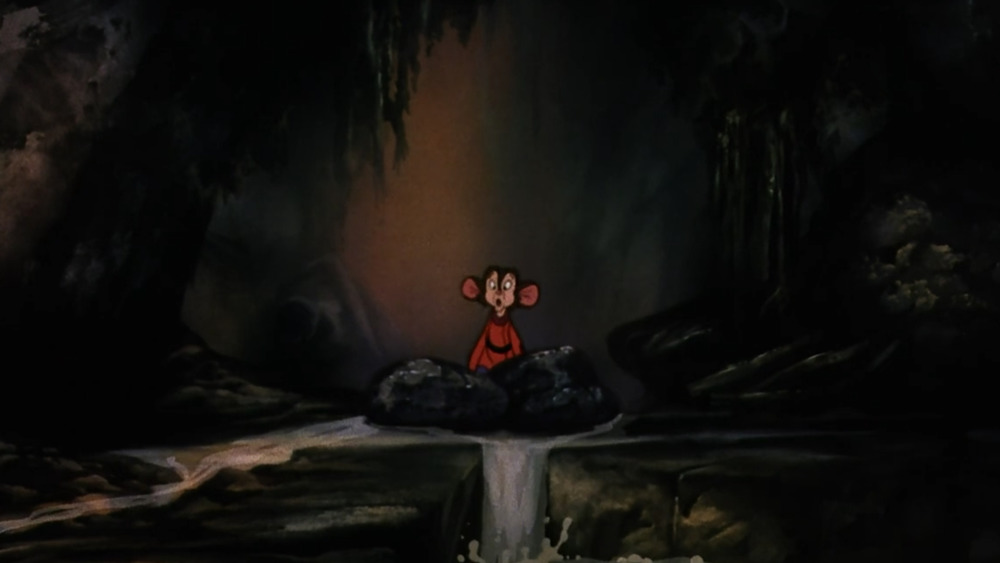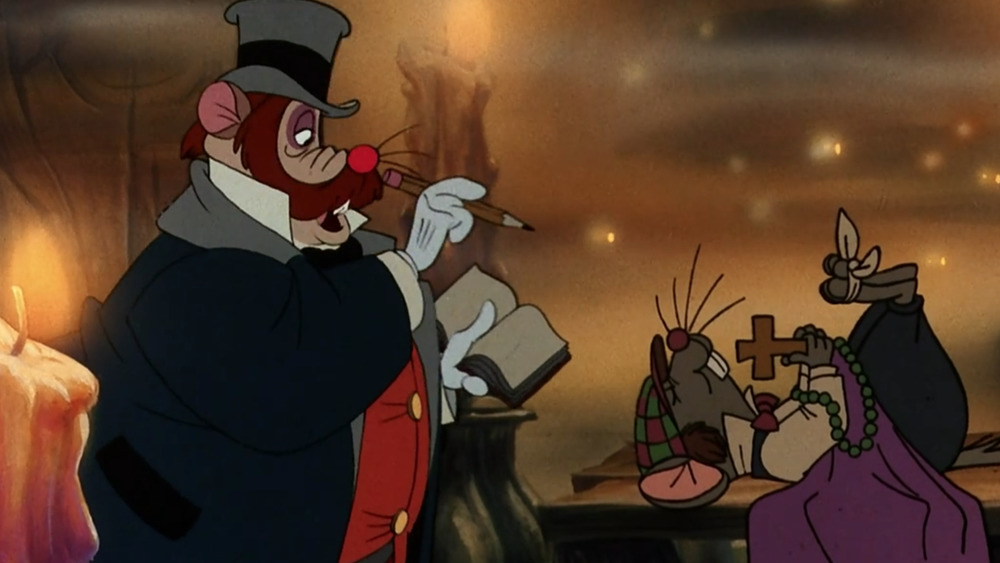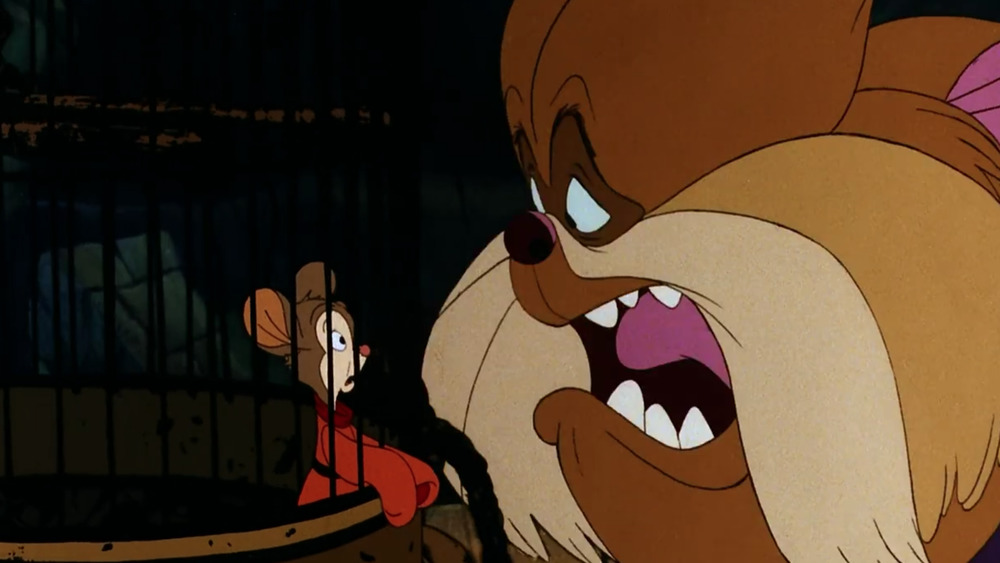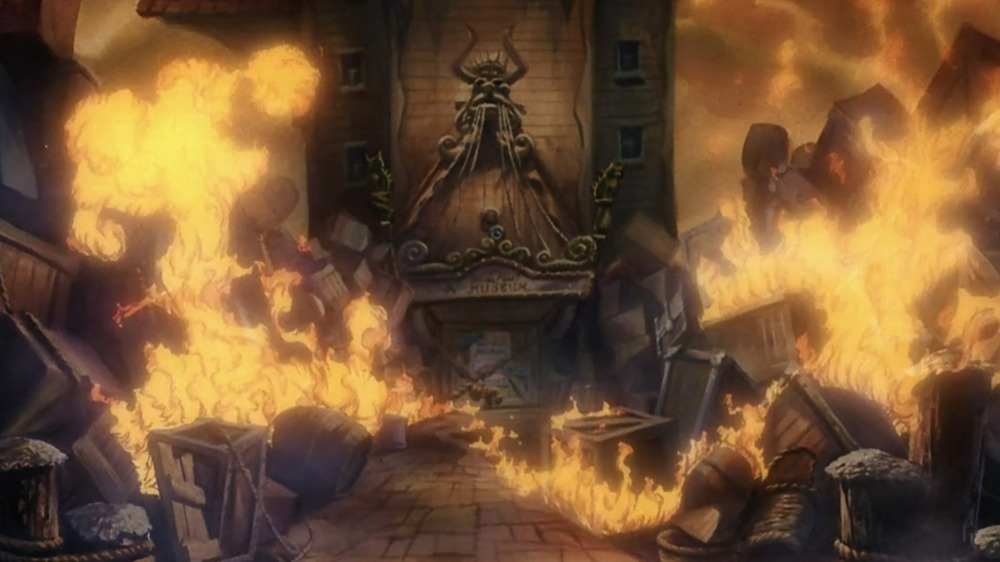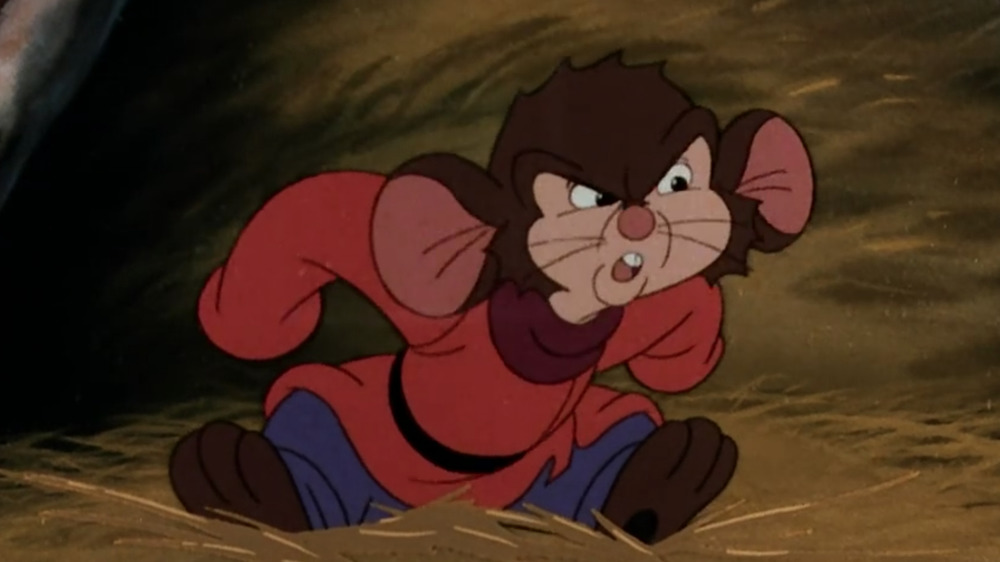Things You Missed As A Kid Watching An American Tail
Before the advent of the internet age, there were a handful of moments in animation that resonated across the pre-adolescent world. For example, in 1986, an entire generation partook in the epic journey of a little mouse named Fievel (Phillip Glasser). An American Tail chronicled his journey from the cold, stark streets of Russia to the bustle of late 19th-century New York City. There was hardly a child in the late '80s who didn't enjoy the mouse-sized adventure, and family home theaters were put through the ringer as multiple viewings of An American Tail were a staple of childhood entertainment.
Younger generations were captivated by the slew of characters that washed across the screen. Each character Fievel met had their own unique way of dealing with the indifference of a world that churned out challenges quicker than parents could make the necessary amount of popcorn to satiate their movie-watching children. And when you viewed An American Tail as a kid, you likely were drawn to characters such as Tiger (a goofy alley cat voiced by the delightful Dom DeLuise), and you probably connected with the innocence of Fievel's worldview. So vivid were all these elements that much of the movie's finer details skated right past your youthful eyeballs. Sitting down for a viewing all these years later will provide a vastly different experience. These are all the things you likely missed as a kid while watching An American Tail.
How did that tiny little mouse survive a storm at sea?
Anyone with a smidgeon of perspective is aware of the vastness of Earth's oceans. The indifference of the seas is represented in An American Tail by massive waves resembling the mighty Poseidon, rising up into the sky and elbow-dropping the immigrants' vessel as it makes its way across the Atlantic. During a storm, Fievel naively ventures onto the main deck to catch glimpses of its power. The waves wash across the deck and sweep Fievel away, leaving him victim to the elements as the ship continues on its course.
The next time we see Feivel, he's managed to stow away inside a bottle that washes ashore in America. Nothing to question here if you're a child. Fievel was safe and sound in a bottle, of course! But adults are perfectly aware of the improbability of that bottle not only making its way to shore but also landing where it does. Somehow, Fievel finds himself on the same shoreline as his lost family. For how huge the American shoreline is, washing ashore anywhere near Fievel's desired destination is miraculous — let alone within a few city blocks of his family! New York City is an incredibly large place for any human being, and that's amplified drastically for a tiny mouse. The fact that he winds up so close to the rest of his kind is pretty hard to buy.
Henri the Pigeon is far from heroic
The first character that Fievel runs into is a pigeon named Henri (voiced by Christopher Plummer). A joyous aeronaut with a charming top hat. Henri is painted as a welcome sight with an inspiring song that spurs young Fievel onto the next leg of his journey. The pigeon's heroism is strengthened by his reintroduction in the film's final scenes, as Fievel and his family soar over a completed Statue of Liberty. Henri is so cheerful and helpful that children immediately view him as a hero who Fievel was fortunate to come across. But any adult with an ounce of skepticism will find themselves wondering why anyone is singing this inept pigeon's praises.
An American Tail gives a healthy dose of foreshadowing in the fact that Henri isn't everything that he seems. Not only does the pigeon make the wild claim that he's personally constructing the Statue of Liberty — offering up the idea that he's flying around the monument and assembling it himself — but the very first thing he does after discovering Fievel is give him a bath. Bit of a weird thing for some random guy to do with a young kid that just washed ashore. Adding to his lack of heroism is the fact that he doesn't even take part in delivering Fievel to his next destination. Alas, Henri is much too busy constructing "his" statue, so he delegates the task to one of his serenading concubines. His companion is supposed to deliver Fievel to his next destination (the immigration center) but instead drops him off right next to a slave trader named Warren T. Rat (John Finnegan). Gee, Henri, thanks a bunch!
Warren T Rat's size fluctuates in An American Tail
From the rugged landscape of Russia to the New York City streets, the symbol for oppression among the mice of An American Tail is, of course, cats. All these poor immigrant mice are trying to do is escape to a land free of malicious felines so they can consume cheese and live a happy life. But when Warren T. Rat finds Fievel, he sees dollar signs. How lucky for the deceptive slave trader that a fresh-faced youth is plopped down right next to him as he brainstorms more ways to increase his income. Interestingly, though, when Warren and Fievel first stand side by side, they appear to be equals in size. Slowly but surely over the course of the film, this proves to be far from the case.
Fievel later stumbles into the sewers and discovers Warren T. Rat's lair. He's accompanied by a group of cats and reveals himself to be one of them when he removes his fake nose and unfurls his pointy ears. Suddenly, Warren is towering over Fievel. Furthermore, as the other mice discover the deception, he continues to grow in size and matches that of his cat brethren. It's quite a stretch to suggest that a cat would be able to fool others into thinking he's a mouse. This doesn't stop animators from nonchalantly growing Warren's size over the course of the film. Nothing to question here, kids! After all, he does have the correct nose and ears. And in the words of Warren T. Rat himself, "Who you gonna believe? Me or your own eyes?"
An American Tail is a gritty portrayal of the Jewish immigrant experience
The animation of An American Tail pulls a veil over its youthful audience and hides the gritty accuracies being presented. As an adult, it doesn't take much to dig past the family-friendly veneer to expose the truth lying in the subtext. The tale of the Mousekewitz family is inspired by the Jewish immigrant experience of the late 19th century. In Steven Spielberg's biography, it's revealed that the lead character was named after the director's grandfather, whose Yiddish name was Fievel. So yeah, An American Tail was a deeply personal ordeal for Spielberg. And despite director Don Bluth feeling as though kids wouldn't remember the name, Spielberg held strong, and the name stayed.
The two creators worked in tandem and drew inspiration from multiple familial sources. At one point, Fievel looks in on a classroom, pressing his nose against the glass while he stands out in the cold. This was inspired by Spielberg's grandfather telling him tales regarding Jewish children in Russia not being allowed to attend secondary school, but they were allowed to listen from outside through an open window. The film also opens with a Hanukkah celebration and dreamy discussions of a wonderful land called America. The tale of the immigrant experience is quite apparent to anyone old enough to not be distracted by the goofy cockroach in Warren T. Rat's pocket, from the financial struggles of Papa Mousekewitz' musical career to the ever-present threat of their towering oppressors — cats.
Every character Fievel meets is an obvious stereotype
There are a slew of colorful characters that Fievel stumbles across during his journey through New York City. Each one is unique and fun in their own way but also distinctly identifiable by their obvious stereotype. The decision to make Henri the pigeon French is a particular choice that could only exist in the mid-'80s. The Brooklyn native known as Tony Toponi speaks with a thick accent reminiscent of all that is old school New York. (Plus, his sappy lovestruck ordeal with Bridget strains the concept of "love at first sight" to its limits.) Even Warren T. Rat laces his speech with malice and spends his screen time smoking cigars and counting his gold coins.
We wouldn't go so far as to say that any of the characters are one-dimensional, but they all tend to draw a straight line directly to a particular cultural persona. Granted, this is a kid's movie and easily recognizable characters are a staple of youthful amusement. But rewatching An American Tail after all these years shows glaring stereotypes that we didn't even realize were being imprinted on to our younger selves.
Why don't the humans notice all these mice parades and political rallies?
Humans are both blessed and cursed with a keen awareness of any creepy-crawlies that might parade across our peripherals. So heightened is our fear of their intrusion that you may have even leaped to a false alarm as one of those eye squiggly thingies danced across your range of vision. However, that gives us some pause about a pretty major element in this animated flick.
The humans of An American Tail are nothing more than background characters to our primary protagonists, mice. They seem perfectly aware of their existence, though, such as when Fievel gets caught on a record player, and a screaming female shoos him away by chucking shoes at him. So, how is it that most all of the humans in An American Tail are blissfully unaware of the large gatherings of mice all around them? There's even an instance of an army of mice marching in single file, holding torches (birthday candles) while they assemble their "secret weapon" against the cats.
Perhaps we're underestimating the disgusting circumstances of 19th-century city streets, but more than likely, it's storytellers capitalizing on the naivety of their young audience. One thing is for sure, we would be questioning our place in the circle of life if we saw an army of mice marching to the tune of a rodent-led percussion band.
Adults will notice the animation is in a dreary color palette
Children are entertained by strong, bright imagery. This is why a large amount of G-rated animation leans towards the vibrant end of the color spectrum. It may have been the standard definition living room behemoths of televisions past that made us blissfully unaware, but the animation in An American Tail is all cast with a bleak tone. Even our lead character's blue and red outfit leans towards deep navy blues and flat crimson hues. So depressing is the color palette of An American Tail that critics such as Roger Ebert skewered the movie for its inability to entertain children.
An American Tail's dreary qualities are balanced by goofy characters like Digit the Cockroach and the orange tabby cat, Tiger. This doesn't help us feel less morose about the visual tone of the movie as a whole. Maybe we're looking too much into things here, but An American Tail is a lot more depressing than we remember.
Honest John uses dead mice to cast votes
Regressing to childhood would be a welcome adventure, if only to return to a time when our minds would immediately tune out the political. We recall yawning and exiting the room when The West Wing would dominate parental television viewing. Perhaps that's why the social commentary surrounding Honest John (Neil Ross) and his political cohort, Gussie Mausheimer (Madeline Kahn), skated right past us as kids. But as adults, it's actually quite delightful to review the scathing social commentary in An American Tail. A great example would be Mausheimer claiming, "Money isn't everything! I know because I have money, and I have everything." She, of course, nonchalantly pulls the megaphone away from her mouth to proclaim the latter part.
One of the most jarring details involves Honest John and his attendance of a funeral when we first meet him. The rotund politician drunkenly saunters through a wake, boasting that it's his third one of the day. His only offer of condolence is expressing sorrow over the deceased's inability to cast a vote and how he will do him the honor of remedying that situation. He then pulls out a notebook and writes down a new name under the title page "Ghost Votes." The social commentary laced throughout An American Tail is wonderfully muted to the casual viewer. However, you'll get a hearty chuckle if you listen to an off-screen mouse shout at a political rally, "You can talk! You're rich!"
The cats imprison Fievel rather than just eat him
For a group of oppressive figures who are doing a lot of plotting and scheming, the cats make some impractical decisions regarding their favorite snack food. Warren T. Rat obviously likes money, so it makes a certain amount of sense for him to sell off his prey to other mice for gold coins. But Fievel's discovery of his deceit offers up ample reasoning for a mouse-flavored dinner. For some reason, though, rather than just eat Fievel like they do most of the other mice, they decide it'd be better to put him in a cage and assign guard duty to the most inept member of their crew, Tiger. How very fortunate for our primary character.
We usually try to create some wild reasoning behind moves like this one, given that it's a G-rated animated movie meant to be pure unfiltered amusement. But the decision to detain Fievel is one that makes zero sense. There's no ploy to swindle his parents or bait him to get more tasty mouse morsels. The only reason for his imprisonment is so that he can meet Tiger, which we're totally okay with because you have to get Dom DeLuise in there somehow.
The mice practically burn the city down at the end of An American Tail
At the movie's climax, all the mice band together to release their secret weapon on the cats (the Giant Mouse of Minsk), and it's a wild success. The giant contraption chases their tormentors into the bay and forces the cats onto a ship headed for Hong Kong. Kids see a victory, while their parents may be questioning the validity of success. A simple pro/con list would lay out the whole ordeal as a bit counter-productive, especially considering they practically burn down the pier in the process. It's equivalent to burning down your house when you see a spider — understandable but unnecessary.
The resulting celebration is unnecessary considering that all these mice did was shoo away a herd of cats that assembled on a few city blocks. We're thinking they're completely unaware of how much America loves cats. Nonetheless, the momentary triumph over their feline oppressors is lauded as a victory thanks to Fievel, not that they repay him at all. They cheer in celebration while the very hero they're celebrating lies delirious in a burning building. The mice population scatters as the pier is engulfed in flame, and Fievel is left to be washed down into the sewers by fire hoses. They don't deserve Fievel.
Fievel is extremely impressionable
As a child, we learn to adapt to our surroundings. Our youthfulness comes with a resilience to change that's enhanced by millennia of evolution. Youth comes with a caveat, though. We aren't quite sure who we are yet. Our personalities are still forming. We're still gathering knowledge and forming our own philosophies and values. Perhaps that's why only adults notice that Fievel's single consistent attribute is blind trust. His temperament changes based on who he's around for the entire length of An American Tail. The impressionable mouse even goes so far as to renounce his family in less than a minute when he meets some orphans in a dingy alley.
It happens so quickly that Fievel's survival in the Big Apple has to be chalked up to dumb luck. When he meets Henri the Pigeon, he should've rejected his "never say never" philosophy and adopted one closer to "never trust anyone." Once plopped down next to Warren T. Rat, it's all of about 30 seconds before he's marching next to the feline deceiver en route to a phantom destination. We're unsure if Fievel's impressionable nature is his greatest weapon or his largest downfall. He's reunited with his family in the end, so it's easy to lean towards the former, but stumbling blindly forward through life is hardly a practical approach. He may not be the optimal choice for a hero, but we're still talking about him all these years later.
